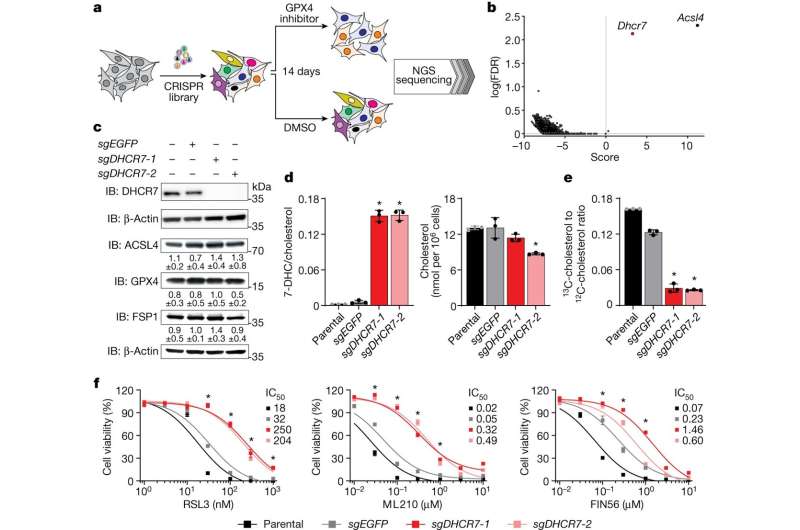This article has been reviewed according to Science X's editorial process and policies. Editors have highlighted the following attributes while ensuring the content's credibility:
fact-checked
peer-reviewed publication
trusted source
proofread
A cholesterol precursor mediates sensitivity to cell death by ferroptosis

A team of scientists from the University of Ottawa and researchers from other universities and research centers around the world has discovered that 7-dehydrocholesterol (7-DHC) is an endogenous suppressor of ferroptosis, which could have important implications for the treatment of cell death-related diseases.
The findings are published in the journal Nature.
Ferroptosis is a form of cell death that is characterized by the accumulation of lipid peroxides and iron-dependent reactive oxygen species (ROS) in cells. It is a regulated process that is distinct from other forms of cell death, such as apoptosis and necrosis.
The researchers identified a pro-ferroptotic activity of 7-dehydrocholesterol reductase (DHCR7) and an unexpected pro-survival function of its substrate, 7-dehydrocholesterol (7-DHC).
"The pro-survival function of 7-DHC was surprising because it more readily forms peroxides than essentially all other lipids, and lipid peroxide formation is generally associated with ferroptosis," explains Derek Pratt, a professor who holds the University Research Chair in Free Radical Chemistry at the Department of Chemistry and Biomolecular Sciences of uOttawa's Faculty of Science.
Professor Pratt and his students Omkar Zilka (Ph.D.), Emily Schaefer (MSc) and Ife Ekpo (BSc) studied how accumulation of 7-DHC could slow ferroptosis, finding that while it is oxidized more quickly than other lipids, the peroxides formed from it are not as toxic to the cell.
The researchers used a combination of genetic and pharmacological approaches to investigate the role of DHCR7 and 7-DHC in ferroptosis. They used CRISPR-Cas9 gene editing to knock out DHCR7 in human cells and found that this increased sensitivity to ferroptosis.
They also showed that reconstitution of DHCR7 activity in these cells restored resistance to ferroptosis. Furthermore, they found that treatment with exogenous 7-DHC protected cells from ferroptosis, while inhibition of 7-DHC synthesis sensitized cells to ferroptosis. These results led the researchers to conclude that 7-DHC is an endogenous suppressor of ferroptosis.
"Perhaps the most exciting aspect is that it would appear that some cancers upregulate 7-DHC to escape ferroptosis, suggesting it may be targeted for cancer treatment," says Professor Pratt.
This study highlights the dual role of 7-DHC in ferroptosis, acting both as a pro-survival shield and as an advantage for tumor growth in Burkitt's lymphoma. The unexpected anti-ferroptosis activity of 7-DHC provides new insights into the intrinsic mechanisms by which cancer cells escape ferroptosis, paving the way for potential therapeutic strategies targeting this metabolic adaptation.
More information: Florencio Porto Freitas et al, 7-Dehydrocholesterol is an endogenous suppressor of ferroptosis, Nature (2024). DOI: 10.1038/s41586-023-06878-9
Journal information: Nature
Provided by University of Ottawa




















